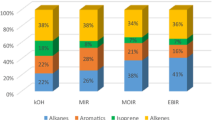Abstract
A statistically relevant correlation between the reaction rate coefficient, k OH, for the OH radical reaction with 161 organic compounds in the gas phase at 300 K, and the corresponding vertical ionisation energies E i,v, reveals two classes of compounds: aromatics where −log(k OH/cm3s-1)≃3/2E i,v(eV)−2 and aliphatics where −log(k OH/cm3s-1)≃4/5E i,v(eV)+3. The prediction of the rate coefficient, k OH, for the reaction of OH with organic molecules from the above equations has a probability of about 90%. Assuming a global diurnal mean of the OH radical concentration of 5×105 cm3, the upper limit of the tropospheric half-life of organic compounds and their persistence can be estimated.
Similar content being viewed by others
References
AtkinsonR., DarnallK. R., LloydA. C., WinerA. M., and PittsJ. N.jr., 1979, Kinetics and mechanisms of the reactions of the hydroxyl radical with organic compounds in the gas phase. Adv. Photochem. 11, 375–487.
AtkinsonR., 1980, Comments on ‘Predicting gas phase organic molecule reaction rates using linear free-energy correlations. I: O(3P) and OH addition and abstraction reactions, Int. J. Chem. Kinet. 11, 1197–1209.
CrutzenP. J., 1982, The global distribution of hydroxyl, in E. O.Goldberg (ed.), Atmospheric Chemistry, Springer-Verlag, Berlin, Heidelberg, New York, pp. 313–328.
DarnallK. R., AtkinsonR., and PittsJ. N.Jr., 1978, Rate contants for the reaction of the OH radical with selected alkanes at 300 K, J. Phys. Chem. 82, 1581–1584.
GaffneyJ. S. and LevineS. Z., 1979, Predicting gas phase organic molecule reaction rates using linear free-energy correlations. I: O(3P) and OH addition and abstraction reactions, Int. J. Chem. Kinet. 11, 1197–1209.
GreinerN. R., 1970, Hydroxyl radical kinetics by kinetic spectroscopy. VI: Reactions with alkanes in the range 300–500 K, J. Chem. Phys. 53, 1070–1076.
GüstenH., FilbyW. G., and SchoofS., 1981, Prediction of hydroxyl radical reaction rates with organic compounds in the gas phase, Atmos. Environ. 15, 1763–1765.
HeicklenJ., 1981, The correlation of rate coefficients for H-atom abstraction by OH radicals with C−H bond dissociation enthalpies, Int. J. Chem. Kinet. 13, 651–665.
HirotaK. and HatadaM., 1966, Fragmentation of alkyl ketones by electron impact and its theoretical explanation, Sci. Paper, Inst. Phys. Chem. Res. 60, 78–84.
IsoyaT., NagumoT., and HirotaK., 1968, Scission probabilities of skeletal bonds in the mass spectra of alkyl acetates, Z. Phys. Chem. N. F. 61, 1–9.
KlasincL., KovaćB., and GüstenH., 1983, Photoelectron spectra of acenes. Electronic structure and substituent effects, Pure Appl. Chem. 55, 289–298.
LorenzK. and ZellnerR., 1983, Kinetics of the reaction of OH-radicals with benzene, benzene-d6 and naphthalene, Ber. Bunsenges. Phys. Chem. 87, 629–636.
MulderP. and LouwR., 1982, Gas phase reactions of hydroxyl radicals with acenes, Tetrahedron Lett. 23, 2605–2608.
NikiH., MakerP. D., SavageC. M., and BreitenbachL. P., 1978, Relative rate constants for the reaction of hydroxyl radicals with aldehydes, J. Phys. Chem. 82, 132–134.
RinkeM. and ZetzschC., 1984, Rate constants for the reaction of OH radicals with aromatics: benzene, phenol, aniline, and 1,2,4-trichlorobenzene, Ber. Bunsenges. Phys. Chem. 88, 55–62.
Rosenstock, H. M., Draxl, K., Steiner, B. W., and Herron, J. T., 1977, Energetics of gaseous ions, J. Phys. Chem. Ref. Data 6, Suppl. 1.
ScheeleB., 1980, Reference chemicals as aids in evaluating a research programme — Selection aims and criteria, Chemosphere 9, 293–309.
Zetzsch, C., 1982, Predicting the abiotic degradability of organic chemicals in the atmosphere by OH using structure reactivity relations; Conference on ‘Chemicals in the Environment’, Copenhagen, 18–20 Oct. 1982, pp. 302–312.
Author information
Authors and Affiliations
Rights and permissions
About this article
Cite this article
Güsten, H., Klasinc, L. & Marić, D. Prediction of the abiotic degradability of organic compounds in the troposphere. J Atmos Chem 2, 83–93 (1984). https://doi.org/10.1007/BF00127264
Received:
Revised:
Issue Date:
DOI: https://doi.org/10.1007/BF00127264




